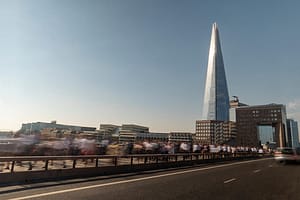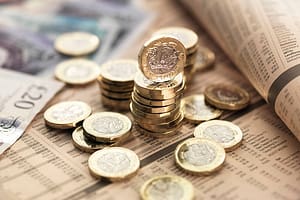Find out how Bernie Ecclestone made a 10,000 per cent return on investment in LondonlovesBusiness.com’s exclusive 3-part interview
By Christian Sylt, with Caroline Reid
People often ask how Bernie Ecclestone got control of Formula 1. After all, he didn’t invent the sport. It has been around since 1946. How did one man manage to pocket the majority of the sport’s profits, totalling billions?
I’ve spent years researching Formula 1’s history and talking to Ecclestone to hear his side.
- Catch up on part 1 of our exclusive Bernie Ecclestone interview
Here’s what really happened.
Son of a Suffolk trawlerman, Ecclestone left school at 16. He then established one of the UK’s biggest car dealerships while dabbling in driving. In 1958 he entered two F1 races but gave up when he failed to qualify on both occasions. He had his eye on a grander prize.
At the time F1 was dominated by glamorous Italian manufacturers such as Ferrari, Alfa Romeo and Maserati, and among the drivers were the likes of Prince Bira of Siam, Count Carel Godin de Beaufort and Alfonso, Marquis de Portago. They were generally wealthy people with a passion for motor racing, and F1 was a hobby for them.
Cars competed in their national racing colours because F1’s governing body the Fédération Internationale de l’Automobile (FIA) did not allow sponsorship. However, in 1968, oil companies BP and Shell withdrew from F1, and Firestone decided it would start charging for tyres. To boost the teams’ income the FIA decided to permit sponsorship in F1 for the first time.
- Read part 3: An exclusive backstage look inside the private world of Bernie Ecclestone
Lotus was one of the first teams to take advantage of this and it signed a deal with the Imperial Tobacco company which led to it running a livery in the red and gold colours of its cigarette packets. Ecclestone saw the money-making potential and took over the Brabham team in 1972.
Under Ecclestone’s ownership Brabham won the world championship twice in the 1980s, but he was not satisfied running a team. He saw even bigger prize: running the whole sport.
With Ecclestone they had a business. Without him, just a show for petrolheads.
At the time, F1 races ran as ad hoc, almost amateur, events. Each team made separate deals with each event promoter and TV coverage was sporadic since races could be cancelled at the last moment if there were not enough cars to fill the grid.
How Bernie seized control
It was then that Ecclestone struck. In 1981 he convinced the teams to sign a contract, called the Concorde Agreement, committing them to race at every Grand Prix. He took this contract to TV companies who would then guarantee coverage. Ecclestone’s company Formula One Promotions and Administration (FOPA) negotiated the deals and took a share of the proceeds with the remainder going to the teams and the FIA.
Why did the teams allow Ecclestone to do this? The answer is that the teams were so chaotic and fractious, they knew only Ecclestone could make the sport work.
With Ecclestone they had a business. Without him, just a show for petrolheads.
Before the teams could complain about what they had given away Ecclestone immediately proved his worth.
In 1982, he signed a three-year deal with the European Broadcasting Union (EBU) which would ensure consistent coverage in F1’s biggest markets in Europe. With guaranteed TV exposure, sponsors’ rates increased in F1 and this gave the teams more money to spend on cutting edge technology in a bid to win. In turn, this attracted the best drivers which made the sport even more appealing to broadcasters and so the fees from TV stations increased. Once F1 had established itself, Ecclestone unshackled it from the EBU and he says this was one of the most important deals in the history of the sport.
I put this to Ecclestone during our interview at Prince’s Gate.
Ecclestone’s company FOPA grew from £7.6m revenue to £83.7m in five years
“They all said there was no way you could ever deal with the companies individually. They are all EBU and you’ve got to deal with the EBU. But the first people I signed was the BBC. I think that was a big stepping stone for Formula One,” recalls Ecclestone, adding “the other thing that wasn’t easy was getting broadcasters and teams to take the on-board camera, if you can believe it. We overcame that.”
In fact, it massively increased F1’s popularity. And the best was yet to come.
In 1988 Ecclestone sold Brabham in order to concentrate on running FOPA. Such was the popularity of the sport, there were more teams than grid spaces and a ‘pre-qualifying’ competition had to be held to weed out the weakest. By the early 1990s the top drivers were commanding salaries of $10-12m, five or six times what they received a decade earlier, and sponsors were spending an estimated total of $400m a season. Big name car manufacturers such as Honda, Renault, Porsche and Lamborghini became involved through supplying engines to the teams.
Even when F1 hit dark days, Ecclestone managed to steer the sport away from disaster.
In 1994, F1’s biggest star Ayrton Senna was killed at the San Marino Grand Prix. It looked like the sport was facing its darkest hour. However, Senna’s death drew the world’s attention to F1 at a time when there was plenty of drama on the track. The sponsors kept pumping in significant financial support. The sport grew faster than ever. And it hasn’t stopped growing.
The figures are stunning: proof of Ecclestone’s genius.
In 1990 FOPA had revenues of just £7.6m but by 1995 this had ballooned to £83.7m.
Ecclestone’s salary of £54.9m made him the world’s highest-paid executive.
Bernie cashes out
Today Ecclestone no longer owns the majority rights to Formula 1. Control has passed to a private equity firm CVC.
Again, people ask why he sold.
The story is too complicated for most journalists to understand, so the story gets forgotten or misreported. It’s actually quite a saga – one which demonstrates the genius of the man.
When Ecclestone became an official pensioner he suffered from heart problems which culminated in him having a triple bypass in 1999. The outlook was far from clear and Ecclestone wanted to leave a significant financial legacy for his Croatian wife Slavica, whom he had married in 1985, and their two young children. Slavica is 24 years his junior and Ecclestone’s two concerns were ensuring that his family would be financially secure if he were to die and also ensuring that F1 grew even bigger than it was at the time.
Ecclestone feared for his legacy. Without him F1 might struggle, even perish. So he pulled two big tricks.
Ecclestone made an annual return on investment of over 10,000 per cent
On 19 December 1995 the FIA transferred to Ecclestone’s personal investment vehicle, FOCA Administration (now known as Formula One Management), the rights to F1 for 14 years beginning on 1 January 1997. Ecclestone owned 100 per cent of FOCA Administration so this gave him complete control of F1’s rights for the first time in history.
Under the deal the teams got 25 per cent of F1’s profits with Ecclestone getting 75 per cent. The FIA, which regulates the sport, got a paltry £6m annual fee. In short, Ecclestone made an annual return on investment of over 10,000 per cent.
It was the best business move of his career and handed him the keys to the billionaire’s club.
- Read part 3: An exclusive backstage look inside the private world of Bernie Ec
clestone
How did he do this? Again, the teams knew that only Bernie could keep the sport growing at an astounding level. Only he could stop the teams walking off and trying to set up their own rival versions. So the deal made sense.
And it is thanks to this deal that Ecclestone has been able to steer F1 to huge commercial success as, unlike some other sports, it has not been run by a committe. This allowed it to make quick decisions.
The deal also allowed Ecclestone to float or sell his business to generate enough money to ensure his family would be financially secure if he died. Previously this was difficult to do since his company had only managed the rights and not owned them directly.
Owning the F1 rights gave FOCA Administration assets which generated £218.6m in annual revenue in 1997 and in excess of £5.5bn over the lifetime of its 14-year contract with the FIA. In 1999 Ecclestone secured a $1.4bn bond on the future revenues from F1’s rights. This meant his family would be fabulously wealthy no matter what happened to him. He also embarked on several failed flotation attempts followed by sales of shares in the business, a stage which ended when private equity firm CVC bought a majority stake in 2006.
This deal with CVC meant Ecclestone was left with a personal stake of 5.3 per cent with his family trust owning 8.5 per cent, CVC controlling the business with a 63.4 per cent stake and management and advisers making up the remaining minority shareholders.
The result?
Ecclestone remains the king of the sport. Whatever his exact shareholding everyone – including CVC – defers to him.
He has cash in the bank, control of the sport he loves and the teams are thriving as global revenues rocket.
Not bad for the son of a trawlerman from Ipswich.
Roadmap to the Ecclestone family’s F1 riches:
1981: Concorde Agreement committing the teams to race in F1 is signed.
1995: Ecclestone pays himself a £54.9m salary making him the world’s highest-paid executive.
1997: Ecclestone takes over the F1 rights directly for £6m per year
1999: The Ecclestone family’s trust gets $1.4m from a bond secured on F1’s future revenues.
2000: The trust collects $1bn from selling 50 per cent of F1’s rightsholder to two private equity firms, Hellman & Friedman and Morgan Grenfell.
2001: The trust gets $987.5m when German media business Kirch backs an option to acquire another 25 per cent of F1’s rightsholder after it had already begun acquiring the 50 per cent previously held by the private equity firms.
2006: The trust receives $478m from its 25 per cent stake in F1’s rightsholder which is sold to private equity firm CVC. The trust buys back 8.5 per cent of the business.
ECCLESTONE’S TOTAL FROM F1: $3.9bn
(Source: www.formulamoney.com)
Christian Sylt is a full-time writer on the finances of Formula 1. He co-edits with Caroline Reid the annual commercial guide to the sport, Formula Money, which details what every sponsor spends, driver salaries and team incomes.
TOMORROW: An exclusive backstage look inside the private world of Bernie Ecclestone.




Leave a Comment